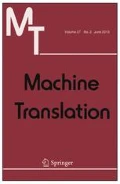Abstract
Anaphora resolution in machine translation involves two aspects:(1) the identification of the antecedent, i.e., the determinationof co-reference relations between anaphor and antecedent; and (2)the translation of the anaphor, i.e., the selection of theappropriate target-language equivalent. The identification ofthe antecedent is essentially a monolingual, language-pairindependent problem which is usually solved during analysis. Theselection of the target-language equivalent, on the other hand,can be regarded as a language-pair dependent task which has to betackled during transfer and generation. In this paper, theproblems of anaphora translation are discussed for the languagepair Russian–German. Although in most cases source-languageanaphoric pronouns correspond to target-language anaphoricpronouns, in some cases this straightforward equation does nothold. Two cases of such translation discrepancies are treatedhere: zero anaphora and pronominal PPs. The differences in thedistribution of zero anaphora and pronominal PPs in Russian andGerman are described, and solutions to these translation problems basedon the Russian–German MT system T1 are presented.
Similar content being viewed by others
References
Engel, Ulrich: 1996, Deutsche Grammatik [German grammar], Heidelberg, Julius Groos.
Geldbach, Stefanie: 1997, ‘Pronominale Referenzen in der maschinellen Übersetzung: Ein Verfahren zur Anaphernresolution' [Pronominal Reference in Machine Translation: An Experiment in Anaphora Resolution]’, Sprache und Datenverarbeitung 21(2), 76-85.
Geldbach, Stefanie and Iris Höser: 1997, ‘Zur Behandlung subjektloser Sätze [On the Treatment of Subjectless Sentences]’, Sprache und Datenverarbeitung 21(2), 49-57.
Hauenschild, Christa, Bernd Mahr, Susanne Preuß, Birte Schmitz, Carla Umbach, Wilhelm Weisweber, Lone Behesty, Guido Dunker, Rickard Matthew, Christian Werner-Maier, and Erich Ziegler: 1993, Anapherninterpretation in der maschinellen Übersetzung: Schluβbericht des Berliner Projektes der EUROTRA-D-Begleitforschung [Anaphora Interpretation in Machine Translation: Final Report of the Berlin Project of the EUROTRA-D Supplementary Research], KIT-Report 108, TU Berlin.
Höser, Iris and Gerda Klimonow: 1994, ‘Russisch-Deutsch: ein neues METAL-Sprachpaar’ [Russian-German: A New METAL Language Pair], Sprache und Datenverarbeitung 18(1), 53-64.
Lappin, Shalom and Herbert Leass: 1994, ‘An Algorithm for Pronominal Anaphora Resolution’, Computational Linguistics 20, 535-561.
Mitkov, Ruslan and Branimir Boguraev (eds): 1997, Proceedings of the ACL'97/EACL'97 Workshop on Operational Factors in Practical, Robust Anaphora Resolution, Madrid, Spain.
Mitkov, Ruslan and Paul Schmidt: 1998, ‘On the Complexity of Pronominal Anaphora Resolution in Machine Translation’, in Carlos Martin-Víde (ed.), Mathematical and Computational Analysis of Natural Language, Amsterdam, John Benjamins, pp. 207-222.
Rich, Elaine and Susann LuperFoy: 1988, ‘An Architecture for Anaphora Resolution’, Second Conference on Applied Natural Language Processing, Austin, Texas, pp. 18-24.
Author information
Authors and Affiliations
Rights and permissions
About this article
Cite this article
Geldbach, S. Anaphora and Translation Discrepancies in Russian–German MT. Machine Translation 14, 217–230 (1999). https://doi.org/10.1023/A:1011185225416
Issue Date:
DOI: https://doi.org/10.1023/A:1011185225416




